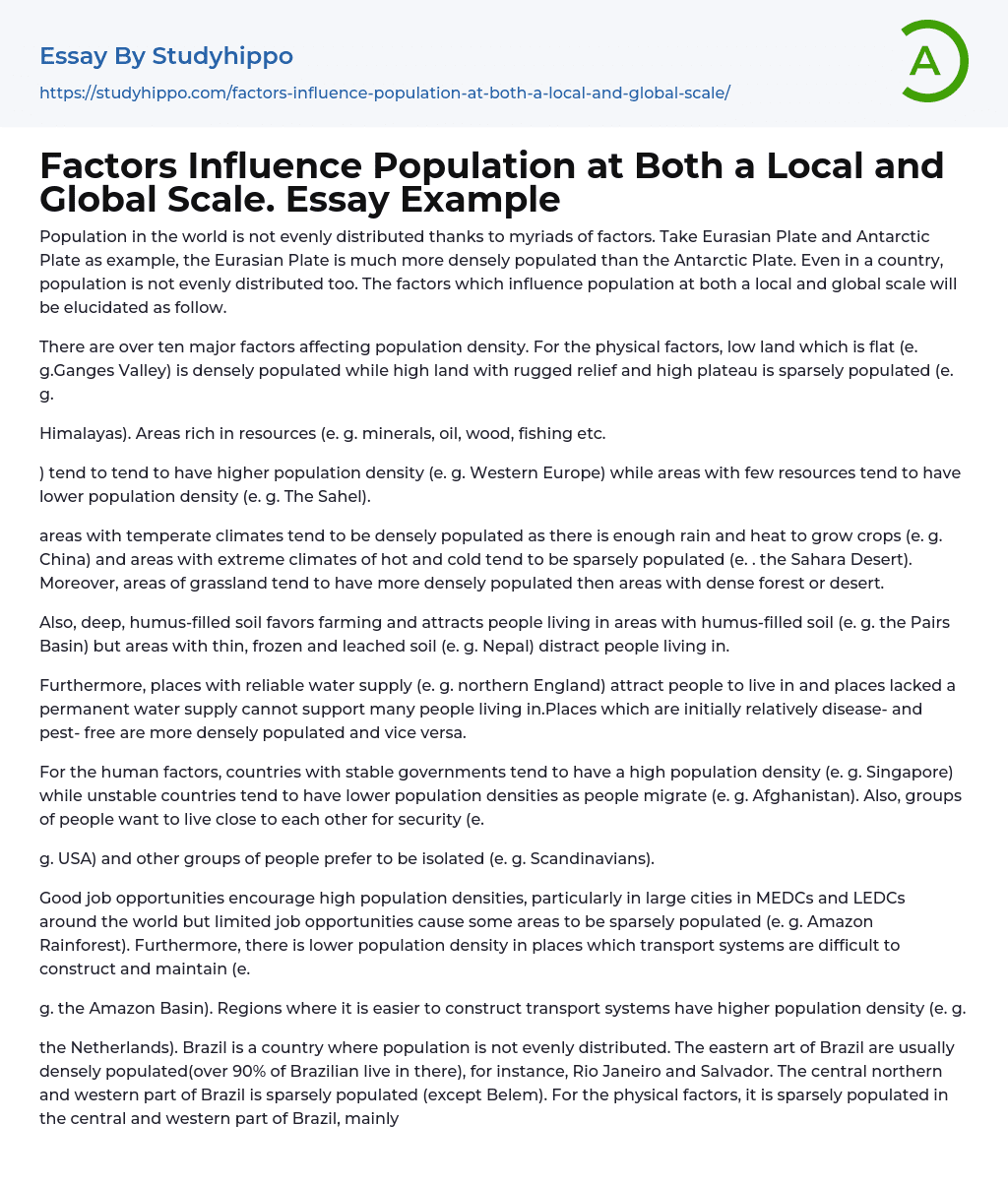

Factors Influence Population at Both a Local and Global Scale. Essay Example
Population in the world is not evenly distributed thanks to myriads of factors. Take Eurasian Plate and Antarctic Plate as example, the Eurasian Plate is much more densely populated than the Antarctic Plate. Even in a country, population is not evenly distributed too. The factors which influence population at both a local and global scale will be elucidated as follow.
There are over ten major factors affecting population density. For the physical factors, low land which is flat (e. g.Ganges Valley) is densely populated while high land with rugged relief and high plateau is sparsely populated (e. g.
Himalayas). Areas rich in resources (e. g. minerals, oil, wood, fishing etc.
) tend to tend to have higher population density (e. g. Western Europe) while areas with few resources tend to have lower population density (e. g. The Sah
...el).
areas with temperate climates tend to be densely populated as there is enough rain and heat to grow crops (e. g. China) and areas with extreme climates of hot and cold tend to be sparsely populated (e. . the Sahara Desert). Moreover, areas of grassland tend to have more densely populated then areas with dense forest or desert.
Also, deep, humus-filled soil favors farming and attracts people living in areas with humus-filled soil (e. g. the Pairs Basin) but areas with thin, frozen and leached soil (e. g. Nepal) distract people living in.
Furthermore, places with reliable water supply (e. g. northern England) attract people to live in and places lacked a permanent water supply cannot support many people living in.Places which are initially relatively disease- and pest- free are more densely populated and vice versa.
For
the human factors, countries with stable governments tend to have a high population density (e. g. Singapore) while unstable countries tend to have lower population densities as people migrate (e. g. Afghanistan). Also, groups of people want to live close to each other for security (e.
g. USA) and other groups of people prefer to be isolated (e. g. Scandinavians).
Good job opportunities encourage high population densities, particularly in large cities in MEDCs and LEDCs around the world but limited job opportunities cause some areas to be sparsely populated (e. g. Amazon Rainforest). Furthermore, there is lower population density in places which transport systems are difficult to construct and maintain (e.
g. the Amazon Basin). Regions where it is easier to construct transport systems have higher population density (e. g.
the Netherlands). Brazil is a country where population is not evenly distributed. The eastern art of Brazil are usually densely populated(over 90% of Brazilian live in there), for instance, Rio Janeiro and Salvador. The central northern and western part of Brazil is sparsely populated (except Belem). For the physical factors, it is sparsely populated in the central and western part of Brazil, mainly due to poor and infertile soil which is disfavor for farming. It is also sparsely populated in the Sertao as clean water supply are lacking.
Physical conditions which disfavor for farming, such as frequent water balance deficit and poor soil, also distract people move to this place.On other hand, as several minerals are found and being exploited, Manaus is moderately populated and Belem is densely populated. Also, Brazilian Plateau and Sao Paulo are not sparsely populated because favorable climate and fertile soil make
it favorable for farming. For the human factors, Sertao has low population density thanks to lack of federal investment and only subsistence economies can be supported.
Since new status as a free port was granted and tourism was being developed in the 1980s, Manus is moderately populated nowadays.The eastern part of the plateau around Sao Paulo and Belo Horizonte and the east coast are densely populated since several natural harbors became ports and thus encouraged trade and the growth of industry. Being the second capital of Brazil, Rio De Janeiro is being developed as an economic, cultural and administrative centre and its population density is become higher. Sao Paulo is regard as one of the fastest-growing cities in the world also become more and more densely populated as it had high levels of federal investment, a good communications network are developed and modern services are provided consequently.Lastly, Brasilia, the new federal capital of Brazil, is also densely populated due to government planning (the government try to redress the imbalance in population density and wealth between the south-east of the country and the interior. In conclusion, all of the aforementioned physical and human factors contribute to the unevenly distribution of population at both a local and global scale.
Places with favorable physical and human factors for human living and economic development will attract people living in and vice versa.
- Alaska essays
- Boston essays
- Brazil essays
- California essays
- Canada essays
- Chicago essays
- Costa Rica essays
- Florida essays
- Hawaii essays
- Latin America essays
- Los Angeles essays
- Mexico essays
- Slavery In America essays
- Usa essays
- Virginia essays
- Washington essays
- Atmosphere essays
- Biodiversity essays
- Coral Reef essays
- Desert essays
- Earth essays
- Ecosystem essays
- Forest essays
- Lake essays
- Natural Environment essays
- Ocean essays
- Oxygen essays
- Rainbow essays
- Sea essays
- Soil essays
- Volcano essays
- Water essays
- Wind essays
- Cultural Assimilation essays
- Demography essays
- Ethnographic essays
- Population essays
- Population Growth essays



